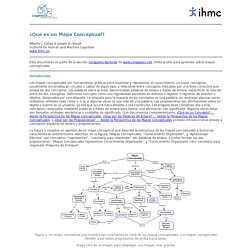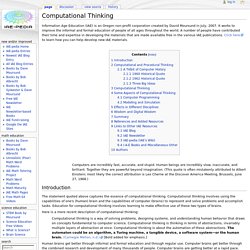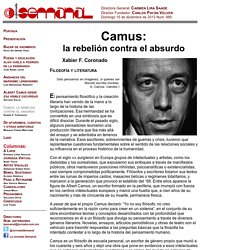

¿Qué es un Mapa Conceptual? ¿Qué es un Mapa Conceptual?

Alberto J. Cañas & Joseph D. Five steps to learning Flash Professional. Creating your first Flash Professional CS5 document. Flash Professional Help. Learn Flash Professional CS6. Adobe Flash Platform * Example: Animation portfolio piece (Flash Professional) Introduction to Computer Science using Java.
Potato and Ham Omelet recipe. Computational Thinking - IAE-Pedia. Information Age Education (IAE) is an Oregon non-profit corporation created by David Moursund in July, 2007.

It works to improve the informal and formal education of people of all ages throughout the world. A number of people have contributed their time and expertise in developing the materials that are made available free in the various IAE publications. Click here to learn how you can help develop new IAE materials. Computers are incredibly fast, accurate, and stupid. Human beings are incredibly slow, inaccurate, and brilliant. Introduction The statement quoted above captures the essence of computational thinking.
Here is a more recent description of computational thinking: Computational thinking is a way of solving problems, designing systems, and understanding human behavior that draws on concepts fundamental to computer science. Human brains get better through informal and formal education and through regular use. Each type of brain has unique capabilities and limitations. Google for Education: Computational Thinking (CT) is a problem solving process that includes a number of characteristics and dispositions.

CT is essential to the development of computer applications, but it can also be used to support problem solving across all disciplines, including math, science, and the humanities. Students who learn CT across the curriculum can begin to see a relationship between subjects as well as between school and life outside of the classroom. CT involves a number of skills, including: These skills are supported and enhanced by a number of dispositions or attitudes that include: Confidence in dealing with complexity Persistence in working with difficult problems Tolerance for ambiguity The ability to deal with open ended problems The ability to communicate and work with others to achieve a common goal or solution See our Computational Thinking Concepts Guide for a printable version of this list, along with teaching tips for each concept.
Guide to Philosophy on the Internet (Suber), Journals. Camus: la rebelión contra el absurdo. Camus: la rebelión contra el absurdo Xabier F.

Coronado Filosofía y literatura Sólo pensamos en imágenes, si quieres ser filósofo escribe novelas. A. El pensamiento filosófico y la creación literaria han venido de la mano a lo largo de la historia de las civilizaciones. Con el siglo XX surgieron en Europa grupos de intelectuales y artistas, como los dadaístas y los surrealistas, que expusieron sus enfoques a través de manifiestos públicos; otros mantuvieron posiciones nihilistas, psicoanalíticas o existencialistas, casi siempre comprometidas políticamente.
A pesar de que el propio Camus declaró: “Yo no soy filósofo; no creo suficientemente en la razón como para creer en un sistema”, en el conjunto de su obra encontramos teorías y conceptos desarrollados con tal profundidad que reconocemos en él a un filósofo que divulga su pensamiento a través de diversos géneros literarios. Origen y educación: El primer hombre. What Are The Hardest Languages To Learn? [INFOGRAPHIC] Holy infographics: the bible visualised. Definition of Infographics. Infographics - or as known by its long name, information graphics, are visual representations designed with the goal of simplifying complex information or concepts.

By presenting these in graphic form human visual interpretation is enhanced with patterns that basically make the connections for them. The process of creating infographics is also known as data visualization, information design, or information architecture. Humans receive input from the five senses of sight, touch, hearing, smell, and taste but receive significantly more information visually.
By most estimates, fifty percent of the human brain is dedicated to visual functions, and images are processed faster because text is viewed in a linear fashion, which requires more concentration or attention. Infographics have been used since the time when early man was drawing on cave walls. The Do's And Don'ts Of Infographic Design. Advertisement Editor’s Note: You might want to read Nathan Yau’s article The Do’s And Don’ts Of Infographic Design: Revisited1 here on Smashing Magazine which is a response to this article.

Since the dawn of the Internet, the demand for good design has continued to skyrocket. From Web 1.0 to Web 2.0 and beyond, designers have remained on their toes as they define the trends and expectations of our online universe. The Internet is a great designer’s playground, and online businesses are growing more and more appreciative of what can be gained from a bit of well-executed eye candy. Over the past two years, this fact has become the backbone of a growing trend in online marketing: the infographic. Resources. Tea or Coffee? CONAPRED - Portada. VNAE. Centro de Recursos para la Escritura Académica del Tecnológico de Monterrey. Computer Security.
Scammers, hackers, and identity thieves are looking to steal your personal information – and your money.

But there are steps you can take to protect yourself, like keeping your computer software up-to-date and giving out your personal information only when you have a good reason. Use Security Software That Updates Automatically The bad guys constantly develop new ways to attack your computer, so your security software must be up-to-date to protect against the latest threats. Most security software can update automatically; set yours to do so. You can find free security software from well-known companies. If you let your operating system, web browser, or security software get out-of-date, criminals could sneak their bad programs – malware – onto your computer and use it to secretly break into other computers, send spam, or spy on your online activities.